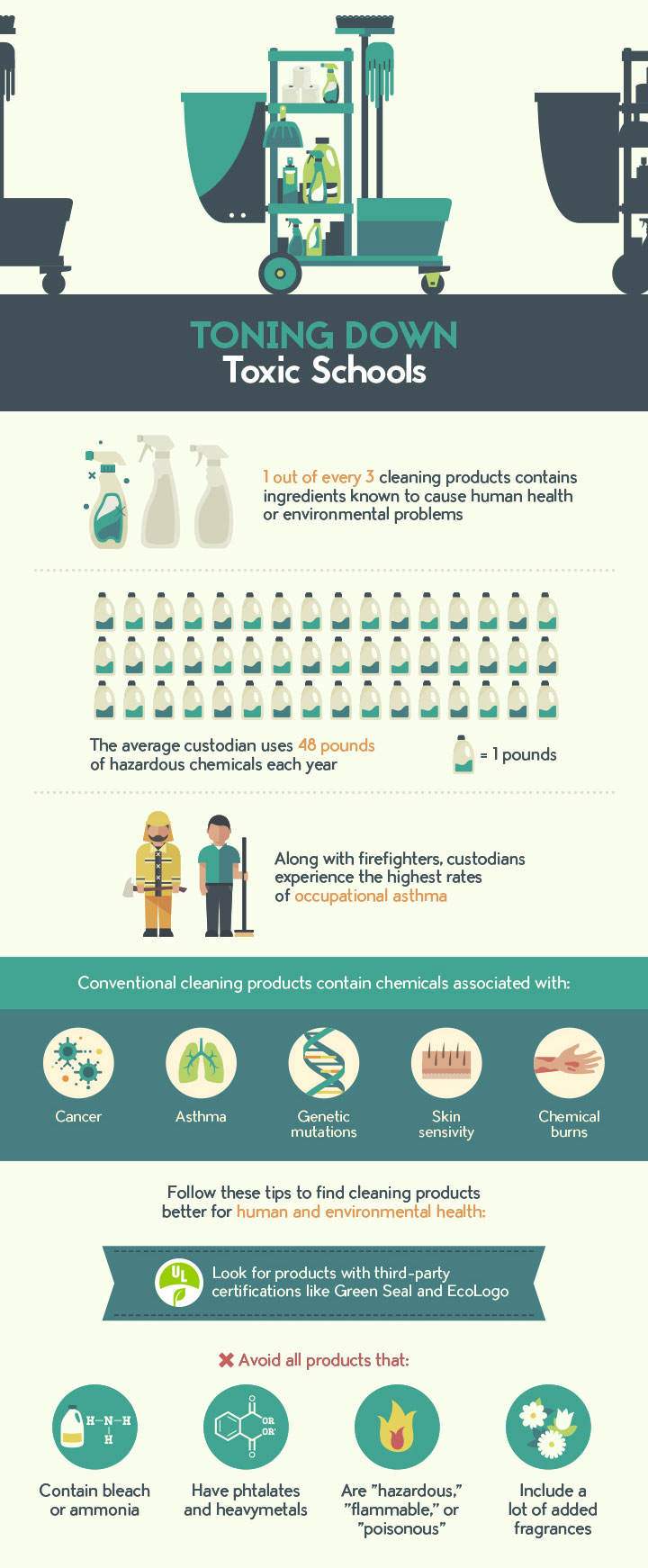A Guide for Students and Parents
Twenty percent of Americans go to school every day. That’s 60 million students, teachers, faculty, and staff who work and learn on our nation’s campuses. And while many schools struggle with funding, standards, and behavior, the issues of the environment and good health sometimes fall through the cracks. That’s a mistake that we need to stop making.
School buildings are the third biggest energy users. A mid-size school district may spend $1 million yearly on energy, a number that is increasing by around 19 percent each year. Meanwhile, poor indoor air quality negatively affects students’ performance, and schools remain a huge source of pollution and waste that degrades the environment.
As a student or parent, big changes at your school may be unpopular, or seem impossible. The reality could not be further from the truth. For example, did you know that Earth Day is the largest civic observance in the world, with more than one billion participants each year? That’s one in every seven people. Even if you think your school administration may be opposed to your ideas, you shouldn’t let that stop you from getting involved. You’re likely to find more support than resistance.
It’s your school (or your kids’ school) and your life. Take action to protect not just the environment, but the health and future of yourself and your kids.
Bring Back Fresh Air & Daylight
Going to school can actually harm your health. Nearly half of all schools (43 percent) have unsatisfactory indoor environmental conditions, and 20 percent have unsatisfactory air quality. That’s partly due to aging school buildings, but also related to an overall decrease in indoor air quality thanks to reduced air circulation and more synthetic substances in our daily lives. One in ten school-age kids now suffer from asthma, so poor air quality isn’t just an annoyance—it can be life threatening.
Without a doubt, the majority of public schools could use upgrades to help combat these dangers. You can help your school take action to improve indoor air quality and reduce exposure to toxic substances for all teachers and students. Here are some ideas to try:
1. Organize classroom cleanup days.
Some of the biggest health concerns lurking in your classroom exists under all your stuff. Cluttered surfaces, cupboards, and corners harbor dust and mold. Organize some classmates or fellow parents to stay after school once a month to declutter. You’ll help reduce asthma triggers, and your teachers and custodians will thank you.
2. Ask your school to implement green cleaning, pest control, and maintenance policies.
Toxic cleaning supplies, pest poisons, paints, furnishing finishes, and even chemical fertilizers and ice melt threaten kids’ health. They’re also toxic to cleaning and maintenance staff. Ask your school administration to seek out green solutions to various issues, including sidewalk weed control, ice melt in the winter months, and cleaning products.
3. Raise funds for air quality meters.
Want to get a clearer idea of what you’re really breathing? Work with students and parents to raise funds for or ask the school to invest in air quality meters, which will help students manage asthma. Additionally, the meters notify the school of any serious air quality issues, such as high CO2 levels, or elevated moisture that could cause mold.
Encourage Healthy & Sustainable Living
The kids of today will be the architects and thought leaders of tomorrow. And schools aren’t just a place for math drills. Schools allow young people to share life experiences and lessons, and to learn the values they’ll carry with them for a lifetime. Unfortunately, American kids are in the midst of a well-documented obesity epidemic, which threatens their longevity. At the same time, climate change is threatening the planet.
The years ahead are full of challenges for today’s kids. By sharing skills for healthy, sustainable living, you can help give them (and their own children) better chances for a long, happy life.
4. Organize a Local Food Day.
Consider teaming up with local restaurants, farms, or even food trucks to bring fresh, local food to school once a month or once every few months. Kids will get a chance to learn the benefits of local food, and you’ll be supporting the small businesses in your community.
5. Set up a green student club.
Take environmental education into your own hands. A student club can take real action on campus issues. Your club may create a campus-wide recycling or composting program; learn about growing your own food with a school garden; organize cleanup and planting days; raise funds for green initiatives; and even take part in statewide and national green schools competitions. Through all this, students will learn leadership, teamwork, and how great feels to make a positive difference.
6. Form a carpooling, cycling, or walking group.
Save time for busy parents, conserve energy, and make friends with a community carpool or other transportation group. By getting together with your neighbors, you can find new, more efficient ways to get to and from school. Carpools are the time-tested solution, but if you live close enough to your school, think about organizing a group to ride bikes or walk together. As a bonus, parent chaperones will get their daily exercise, too.
7. Ask the school to install energy meters.
It’s a lot easier to understand energy use when you can see it in action. Energy meters that are visible to any student and teacher aren’t just great learning tools— they can also encourage everyone to conserve energy and water throughout the day. Many schools have started sharing their energy use in this way. Monitoring not only creates savings for the school’s power, heat, and water budgets, but can also be incorporated into friendly school-wide competitions and classroom sustainability lessons.
Save Money, Save the Environment
If you asked your school administration, they’d probably be the first to tell you that they would love to upgrade your school with more modern, sustainable, and healthy features. Unfortunately, most schools have tight budgets, and they have to make tough choices about how to allocate funds.
That said, it shouldn’t be surprising that environmentally sustainable schools—with increased efficiency and health benefits—are also more financially sustainable. For example:
- Test scores and learning ability improve by three to five percent when a school incorporates natural daylight—equating to an annual earning increase of $532 per student.
- Building a green school costs less than 2 percent more than a conventional school (about $3 per square foot) but provides 20 times the financial benefits.
- A green school saves an average of $100,000 annually—enough to hire two new teachers, buy 250 new computers, or purchase 5000 new textbooks.
- Green schools utilize 33 percent less energy and 32 percent less water than traditional schools.
- On average, a green school produces:
- 1,200 fewer pounds of nitrogen oxides (a principal component of smog)
- 1,300 fewer pounds of sulfur dioxide (a principal cause of acid rain)
- 585,000 fewer pounds of carbon dioxide (the principal greenhouse gas)
- 150 fewer pounds of coarse particulate matter (a principal cause of respiratory illness)
- 74 percent less waste
How can you help your school go green? Start by reducing energy use, water use, waste, and pollution in everyday action. Calculate the savings your actions are creating, and lobby the school district to set aside that money for upgrades and improvements to facilities.
8. Post conservation reminders everywhere.
Simple signs really do make a difference. In every room, bathroom, hallway, and lunchroom, post reminders to students and teachers to turn off lights when they’re not using them; save water while washing their hands; unplug energy-sucking devices; and adjust thermostats when leaving for the day. Be efficient if using paper signs: Paper is a precious resource, too, so be certain your signage will result in a real reduction in your school’s water and power use. Clear your campaign with the administration first. Notify the maintenance staff as well so your hard work doesn’t end up in the waste stream.
9. Start a water bottle campaign.
One of the biggest ways to reduce waste at your school is to get students and teachers to stop using disposable water bottles and other single-use containers. Most schools have plenty of drinking fountains. Organize an education campaign featuring refillable, durable water bottles that everyone can use to cut down on trash and recycling at your school. (Make sure bottles fit your drinking fountains first.)
10. Volunteer as a xeriscaper.
Schools often use a huge amount of water to maintain lawns and landscaping. While a lush, green field may be perfect for running and playing, many traditional landscaping schemes are costly both in water use and maintenance. Offer the school your time to design and install native plants that don’t require a lot of water. A gardening day is also a great outdoor activity for clubs or parent groups.
Green Living is a Learning Process
None of us were born knowing how to live healthily and sustainably. So don’t expect your friends, neighbors, or family members to have the same passion and knowledge about environmental issues that you may have acquired.
That applies to your school in particular. As institutions of learning, schools have recently been challenged with changing standards and expectations, all to be addressed with stagnant budgets. When it comes to going green, most schools are struggling. That’s why it’s a perfect opportunity for parents and students to get involved, get hands-on, and make change happen from the ground up.
If this article has you interested in becoming greener, take a look through these reclaimed wooden desks for your home.—http://www.custommade.com/gallery/custom-desks/









